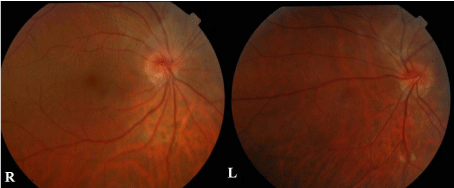
Case Report
Austin J Clin Case Rep. 2014;1(10): 1050.
Neurobrucellosis: Isolated Intracranial Hypertension
Deniz Tuncel1*, Selma Guler2, Sabriye Ozcekic1, Hamza Sahin1 and Mustafa Gokce1
1Department of Neurology Faculty of Medicine, Kahramanmaras Sutcu Imam University, Turkey
2Department of Infectious Diseases Faculty of Medicine, Kahramanmaras Sutcu Imam University, Turkey
*Corresponding author: Deniz Tuncel, Department of Neurology Faculty of Medicine, Kahramanmaras Sutcu Imam University, Hastane cad. No: 50, Kahramanmaras, Turkey
Received: August 25, 2014; Accepted: September 21, 2014; Published: September 24, 2014
Abstract
We present the case of a 22-year-old man who was admitted to hospital with intracranial hypertension, headache, papilledema, and a normal brain imaging. The most common clinical presentation of neurobrucellosis is subacute and chronic meningoencephalitis. Isolated intracranial hypertension in brucella enfections is quite rare, with an incidence reported to be 0,5%. Isolated intracranial hypertension clinic in the differential diagnosis in patients presenting with neurobrucellosis should be considered, especially in endemic areas.
Keywords: Intracranial hypertension; Neurobrucellosis
Introduction
Neurobrucellosis (NB) is a rare complication of brucellosis and sometimes neurological symptoms may be the only symptoms. The incidence of nervous system involvement in brucellosis ranges between 1.7% and 10% in different reports [1]. The most common symptom is subacute and chronic meningoencephalitis. The other presentations are inflammatory peripheral neuritis/radiculitis, inflammatory demyelinative syndromes, papilledema or papillitis without other focal features, meningomyelitis, posterior fossa (ataxic or brainstem) syndromes, and neuropsychiatric syndromes [2-4]. Isolated intracranial hypertension is quite rare presentation of NB. In a study that includes 187 cases of neurobrucellosis, Intracranial hypertension were 0,5% [5,6].
Brucellosis is an endemic zoonosis in Southern Turkey. We report a neurobrucellosis who has isolated intracranial hypertension presentation, and then discuss with literature.
Case Report
The 22-year-old man was admitted to our hospital with a complaint of blurred vision and headache for one month. His physical examination was normal. In the neurological examination, we had revealed bilaterally papilla edema. His neck stiffness, Kernig’s sign had not determined. Cranial computerized tomography with contrast agent and venography were found normal. Serologic studies for known autoimmune and hematological disorders were negative. Cerebrospinal Fluid (CSF) examination revealed increased pressure (310mmH2O), microscopically few leucocytes and lymphocytes (5x10mm3) and elevated protein at 68mg/dl. Brucella (capt test) tube agglutinin was positive at 1/160 titers in blood and positive at spot in CSF. The brucella coombs antiserum was found 1/320. Ceftriaxone (2x1g/day), doxycycline (200mg/daily), rifampicin (600mg/daily), and trimethoprim/ sulfamethaxazole (320/1600mg/daily) were started. In the control examination after one month, his headache and papilla stasis were improved.
Discussion
Central nervous system involvement of brucellosis is a rare, but important complication. The diagnosis of neurobrucellosis is made definitively by isolation of the bacteria in the CNS or presumptively in the context of a systemic brucella infection with a neurologic syndrome and the presence of inflammatory alteration in the CSF that cannot be explained by any other neurologic disease [1,3,4]. Deeb et al categorized neurological involvement in brucellosis into 5 groups: acute meningoencephalitis, meningovascular involvement, central nervous system demyelination, peripheral neuropathy, and papilledema and increased intracranial pressure [2]. The most commonly present with subacute and chronic meningoencephalitis clinic.
Neurobrucellosis occurs in 1,7-10% of cases of brucellosis and only about 0,5% patients presented with intracranial hypertension [5- 9]. We report an unusual case of brucella meningitis presenting with bilateral papilla stasis, headache and absence of other neurological involvement. Both optic neuritis and intracranial hypertension have been involved in papilledema pathophysiology [7,8]. In the present case, the cause of the papilledema depended on primarily increased intracranial pressure. There were not a decrease in visual acuity and inflammation in the retina and vitreus. Rifampicin, doxycycline and trimethoprim/sulfamethaxazole have been found effective and good central nervous system penetration and synergistic actions. We have used these antibiotics and received good response to therapy. The ceftriaxone ceased at 14th day of treatment.
Figure 1: Bilateral papilledema in our neurobrucellosis case.
In conclusion, brucellosis is still endemic in Turkey and presents a major public health, clinical, and diagnostic problem. Neurobrucellosis should be considered in the unexplained intracranial hypertension, especially in endemic areas.
References
- Akdeniz H, Irmak H, Anlar O, Demiröz AP. Central nervous system brucellosis: presentation, diagnosis and treatment. J Infect. 1998; 36: 297-301.
- al Deeb SM, Yaqub BA, Sharif HS, Phadke JG. Neurobrucellosis: clinical characteristics, diagnosis, and outcome. Neurology. 1989; 39: 498-501.
- Kizilkilic O, Calli C. Neurobrucellosis. Neuroimaging Clin N Am. 2011; 21: 927-937, ix.
- Guven T, Ugurlu K, Ergonul O, Kocagul Celikbas A, Eren Gok S, Comoglu S, et al. Neurobrucellosis: Clinical and diagnostic features. Clin Infect Dis. 2013; 56: 1407-1412.
- Gul HC, Erdem H, Bek S. Overview of neurobrucellosis: a pooled analysis of 187 cases. Int J Infect Dis. 2009; 13: e339-343.
- Ozisik HI, Ersoy Y, Refik Tevfik M, Kizkin S, Ozcan C. Isolated intracranial hypertension: a rare presentation of neurobrucellosis. Microbes Infect. 2004; 6: 861-863.
- Yilmaz S, Serdaroglu G, Gokben S, Tekgul H. A case of neurobrucellosis presenting with isolated intracranial hypertension. J Child Neurol. 2011; 26: 1316-1318.
- Sinopidis X, Kaleyias J, Mitropoulou K, Triga M, Kothare SV, Mantagos S. An uncommon case of pediatric neurobrucellosis associated with intracranial hypertension. Case Rep Infect Dis. 2012; 2012: 492467.
- Akhondian J, Ashrafzadeh F, Beiraghi Toosi M, Hashemi N. A rare presentation of neurobrucellosis in a child with recurrent transient ischemic attacks and pseudotumor cerebri (A case report and review of literature). Iran Child Neurol. 2014; 8: 65-69.
